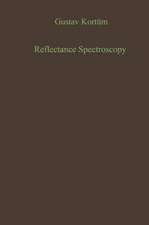Scanning Tunneling Microscopy II: Further Applications and Related Scanning Techniques: Springer Series in Surface Sciences, cartea 28
Editat de Roland Wiesendanger Contribuţii de W. Baumeister Editat de Hans-Joachim Güntherodt Contribuţii de P. Grütter, R. Guckenberger, H.-J. Güntherodt, T. Hartmann, H. Heinzelmann, H.F. Knapp, H.J. Mamin, E. Meyer, D. W. Pohl, D. Rugar, H. Siegenthaler, U. Staufer, H.K. Wickramasinghe, W. Wiegräbe, R. Wiesendangeren Limba Engleză Paperback – 4 aug 1995
Din seria Springer Series in Surface Sciences
- 18%
 Preț: 1131.25 lei
Preț: 1131.25 lei - 15%
 Preț: 654.77 lei
Preț: 654.77 lei - 18%
 Preț: 1113.09 lei
Preț: 1113.09 lei -
 Preț: 390.63 lei
Preț: 390.63 lei -
 Preț: 407.98 lei
Preț: 407.98 lei - 15%
 Preț: 657.57 lei
Preț: 657.57 lei - 15%
 Preț: 636.63 lei
Preț: 636.63 lei - 15%
 Preț: 641.20 lei
Preț: 641.20 lei - 15%
 Preț: 651.19 lei
Preț: 651.19 lei - 15%
 Preț: 645.60 lei
Preț: 645.60 lei - 15%
 Preț: 632.70 lei
Preț: 632.70 lei - 15%
 Preț: 640.24 lei
Preț: 640.24 lei - 15%
 Preț: 646.11 lei
Preț: 646.11 lei -
 Preț: 397.38 lei
Preț: 397.38 lei -
 Preț: 386.22 lei
Preț: 386.22 lei -
 Preț: 387.75 lei
Preț: 387.75 lei -
 Preț: 389.31 lei
Preț: 389.31 lei -
 Preț: 399.12 lei
Preț: 399.12 lei -
 Preț: 406.42 lei
Preț: 406.42 lei - 18%
 Preț: 1011.14 lei
Preț: 1011.14 lei - 18%
 Preț: 2100.88 lei
Preț: 2100.88 lei -
 Preț: 398.35 lei
Preț: 398.35 lei -
 Preț: 389.88 lei
Preț: 389.88 lei - 15%
 Preț: 646.43 lei
Preț: 646.43 lei - 15%
 Preț: 643.16 lei
Preț: 643.16 lei - 15%
 Preț: 643.65 lei
Preț: 643.65 lei - 18%
 Preț: 948.79 lei
Preț: 948.79 lei - 15%
 Preț: 641.03 lei
Preț: 641.03 lei - 15%
 Preț: 640.55 lei
Preț: 640.55 lei - 15%
 Preț: 640.71 lei
Preț: 640.71 lei - 18%
 Preț: 952.72 lei
Preț: 952.72 lei - 18%
 Preț: 955.08 lei
Preț: 955.08 lei - 15%
 Preț: 648.42 lei
Preț: 648.42 lei - 15%
 Preț: 641.03 lei
Preț: 641.03 lei - 18%
 Preț: 1000.42 lei
Preț: 1000.42 lei - 18%
 Preț: 952.57 lei
Preț: 952.57 lei - 18%
 Preț: 1001.02 lei
Preț: 1001.02 lei
Preț: 392.21 lei
Nou
Puncte Express: 588
Preț estimativ în valută:
75.05€ • 78.56$ • 62.46£
75.05€ • 78.56$ • 62.46£
Carte tipărită la comandă
Livrare economică 31 martie-14 aprilie
Preluare comenzi: 021 569.72.76
Specificații
ISBN-13: 9783540585893
ISBN-10: 3540585893
Pagini: 368
Ilustrații: XIV, 349 p. 91 illus., 2 illus. in color.
Dimensiuni: 155 x 235 x 19 mm
Greutate: 0.51 kg
Ediția:Softcover reprint of the original 2nd ed. 1995
Editura: Springer Berlin, Heidelberg
Colecția Springer
Seria Springer Series in Surface Sciences
Locul publicării:Berlin, Heidelberg, Germany
ISBN-10: 3540585893
Pagini: 368
Ilustrații: XIV, 349 p. 91 illus., 2 illus. in color.
Dimensiuni: 155 x 235 x 19 mm
Greutate: 0.51 kg
Ediția:Softcover reprint of the original 2nd ed. 1995
Editura: Springer Berlin, Heidelberg
Colecția Springer
Seria Springer Series in Surface Sciences
Locul publicării:Berlin, Heidelberg, Germany
Public țintă
ResearchCuprins
1. Introduction.- 1.1 STM in Electrochemistry and Biology.- 1.2 Probing Small Forces on a Small Scale.- 1.3 Related Scanning Probe Microscopies.- 1.4 Nanotechnology.- References.- 2. STM in Electrochemistry.- 2.1 Principal Aspects.- 2.2 Experimental Concepts for Electrolytic STM at Potential-Controlled Electrodes.- 2.3 Electrochemical Applications of In Situ STM at Potential-Controlled Electrodes.- 2.4 Outlook.- References.- 3. The Scanning Tunneling Microscope in Biology.- 3.1 Instrumentation.- 3.2 Processing of STM Images.- 3.3 Preparation.- 3.4 Applications.- 3.5 Imaging and Conduction Mechanisms.- 3.6 Conclusions.- References.- 4. Scanning Force Microscopy (SFM).- 4.1 Experimental Aspects of Force Microscopy.- 4.2 Forces and Their Relevance to Force Microscopy.- 4.3 Microscopic Description of the Tip-Sample Contact.- 4.4 Imaging with the Force Microscope.- 4.5 Conclusions and Outlook.- References.- 5. Magnetic Force Microscopy (MFM).- 5.1 Basic Principles of MFM.- 5.2 Measurement Techniques.- 5.3 Force Sensors.- 5.4 Theory of MFM Response.- 5.5 Imaging Data Storage Media.- 5.6 Imaging Soft Magnetic Materials.- 5.7 Resolution.- 5.8 Separation of Magnetic and Topographic Signals.- 5.9 Comparison with Other Magnetic Imaging Techniques.- 5.10 Conclusions and Outlook.- References.- 6. Related Scanning Techniques.- 6.1 Historical Background.- 6.2 STM and Electrical Measurements.- 6.3 STM and Optical Effects.- 6.4 Near-Field Thermal Microscopy.- 6.5 Scanning Force Microscopy and Extensions.- 6.6 Conclusion.- References.- 7. Nano-optics and Scanning Near-Field Optical Microscopy.- 7.1 Nano-optics: Optics of Nanometer-Size Structures.- 7.2 Experimental Work.- 7.3 Plasmons and Spectroscopic Effects.- 7.4 Imaging by SNOM.- 7.5 Discussion, Outlook, Conclusions.- References.- 8.Surface Modification with a Scanning Proximity Probe Microscope.- 8.1 Overview.- 8.2 Microfabrication with a Scanning Probe Microscope.- 8.3 Investigation of the Fabrication Process.- 8.4 Review of SXM Lithography.- 9. Recent Developments.- 9.1 STM and SFM in Electrochemistry.- 9.2 STM in Biology.- 9.3 Scanning-Force Microscopy.- 9.4 Nano-Optics and Scanning Near-Field Optical Microscopy: New Developments.- 9.5 Surface Modifications by Scanning-Probe Methods.- References.
Textul de pe ultima copertă
Scanning Tunneling Microscopy II, like its predecessor, presents detailed and comprehensive accounts of the basic principles and broad range of applications of STM and related scanning probe techniques. The applications discussed in this volume come predominantly from the fields of electrochemistry and biology. In contrast to those described in STM I, these studies may be performed in air and in liquids. The extensions of the basic technique to map other interactions are described in chapters on scanning force microscopy, magnetic force microscopy, and scanning near-field optical microscopy, together with a survey of other related techniques. Also described here is the use of a scanning proximal probe for surface modification. Together, the two volumes give a comprehensive account of experimental aspects of STM. They provide essential reading and reference material for all students and researchers involved in this field. In this second edition the text has been updated and new methods are discussed.


















